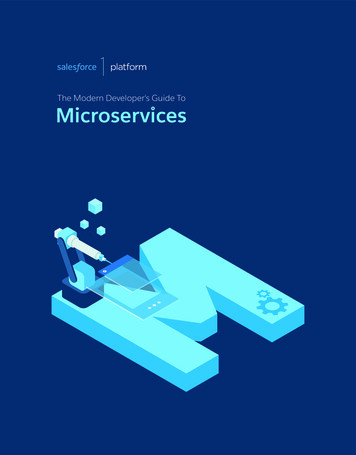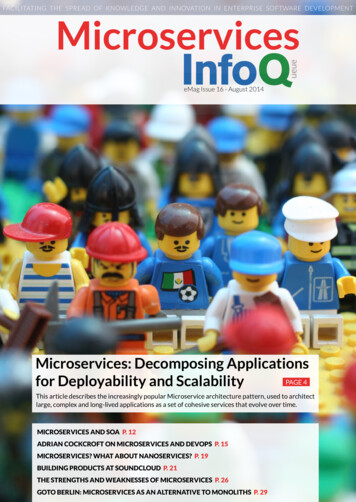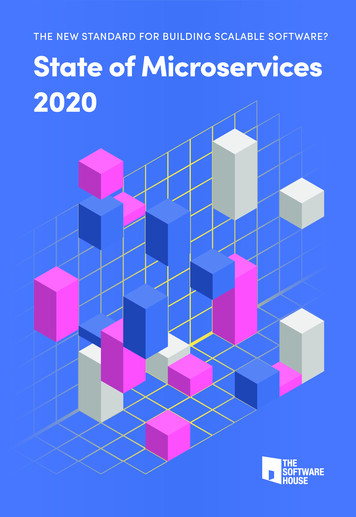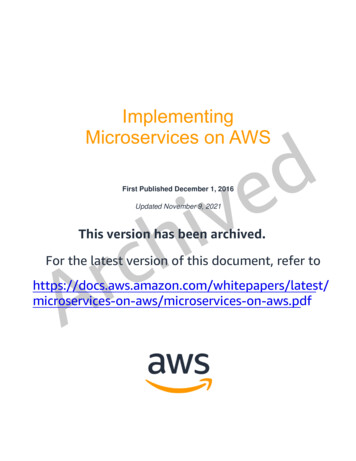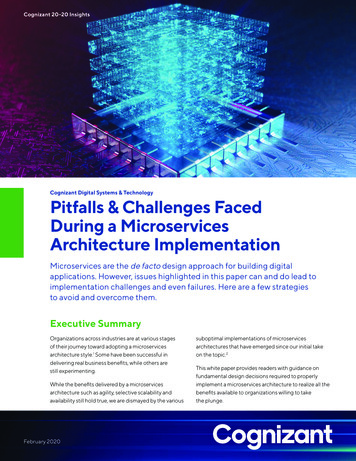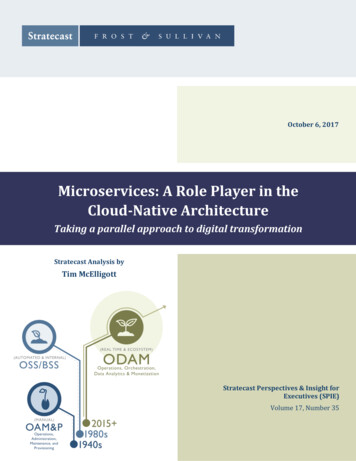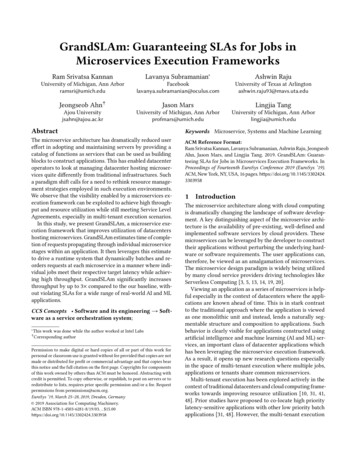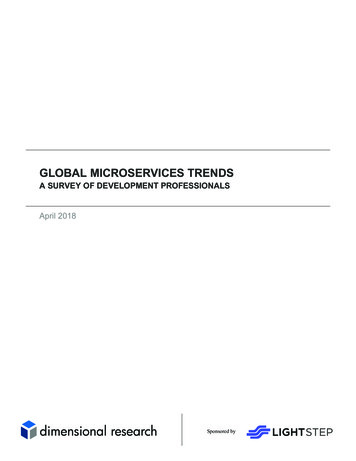
Transcription
GLOBAL MICROSERVICES TRENDSA SURVEY OF DEVELOPMENT PROFESSIONALSApril 2018Sponsored by
GLOBAL MICROSERVICES TRENDSA SURVEY OF DEVELOPMENT PROFESSIONALSDimensional Research April 2018IntroductionTraditionally, software applications were developed as a single project with a single codebase and a single deployedbinary. This worked well for small software applications, but ever-expanding feature lists and the demand forinternet-scale usage patterns inevitably led to sprawling, inflexible, and complex codebases. These “monolithicapplications” were difficult to maintain and operate: since most of the code is tightly coupled, it was difficult tomake even minor changes without unintended consequences. Everyday maintenance, feature updates, scalingupticks, or new security requirements led to recurring nightmares for development and architecture teams,especially with the competitive push towards shorter software release cycles.Technology innovators have embraced microservice architecture as an elegant solution to the manifold problemsinherent to monoliths. By breaking applications down into lightweight and decoupled services that each serve aspecific business need, development teams could deploy more frequently, scale more effectively, and avoid manyof the problems of software monoliths. The promise of microservice architectures was compelling, and buzz grewas many development leaders embraced this new paradigm. But what is happening in real life? Are microservicessolving problems as expected, or simply creating new problems? How is adoption progressing? What are the barriers?The following report, sponsored by LightStep, is based on an online survey of 353 senior development stakeholdersresponsible for microservices adoption working at companies with more than 500 employees. The goal of thissurvey was to capture hard data on current adoption of microservices and gain practical insights into the real-lifeexperiences of development teams.DEFINITION: A “microservice” is a small, independently deployable, independently scalable softwareservice that is designed to encapsulate a specific semantic function in the larger application. Modernapplications can be entirely composed of microservices or leverage microservices as ancillary support for amonolithic application.Sponsored bywww.dimensionalresearch.com 2018 Dimensional Research.All Rights Reserved.
GLOBAL MICROSERVICES TRENDSA SURVEY OF DEVELOPMENT PROFESSIONALSDimensional Research April 2018Key Findings Microservices have become mainstream in the enterprise-- 91% are using or have plans to use microservices-- 60% have microservices in pilot or production-- 92% grew their number of microservices last year-- 92% expect to grow their use of microservices in the coming year-- 86% expect microservices to be the default within five years Microservices adoption driven by need for agility and scalability-- Agility (82%) and scalability (78%) are the top motivators for microservices adoption-- 63% of those with production microservices say they are already successful Expect challenges and changes on the microservices journey-- 99% report challenges with using microservices-- 56% say each additional microservice increases operational challenges-- 73% find troubleshooting is harder in a microservices environment-- 98% of those that face issues identifying the root cause of issues in microservices environments report it has adirect business impact-- 87% of those in production report microservices generate more application data Microservices performance management will be critical to success-- Additional performance management capabilities desired by microservice stakeholders-- 74% plan to increase their microservice performance management investment in the coming yearPage 3www.dimensionalresearch.com 2018 Dimensional Research.All Rights Reserved.
GLOBAL MICROSERVICES TRENDSA SURVEY OF DEVELOPMENT PROFESSIONALSDimensional Research April 2018Detailed Findings: Microservices have become mainstream in the enterpriseEnterprises are on a microservices adoption journeyMicroservices have become ubiquitous among enterprise development teams. About 9 in 10 (91%) are currentlyusing or have plans to use microservices. For well over half (60%), adoption is already advanced. This includesclose to a third (29%) who already depend on production microservices for their applications, and a further third(31%) that have an active pilot or proof-of-concept running.How would you characterize your company’s use of 0%We depend on microservices in productiontodayWe are running a pilot or proof-of-conceptwith microservicesWe are developing microservices but theyare not yet deployedWe are planning to develop microservicesbut have not startedWe do not have microservices and have noplans for them9%90%100%METHODOLOGY: The individuals who indicated that they had no plans for microservices were not askedfurther questions, as the goal was to focus on real-life experiences, not just opinions. The remainder of thisresearch report includes feedback only from the 322 participants (91%) who are currently using or planningto use microservices.Microservices growth is explosiveThe use of microservices is moving incredibly quickly. In the past year, the vast majority of development teamsat large companies (92%) reported an increase in their number of microservices. This included over a third (36%)who went from having no microservices to having some, and a quarter (26%) that characterized their increase as“significant.” Only 8% reported no change in their number of microservices in the past year, and none (0%) reportedthat they had decreased.How has the number of microservices at your company changed in the PAST year?Introduced microservices for the first time36%30%26%8%Increased slightlyIncreased significantlyNo change0%Page h.com100% 2018 Dimensional Research.All Rights Reserved.
GLOBAL MICROSERVICES TRENDSA SURVEY OF DEVELOPMENT PROFESSIONALSDimensional Research April 2018Similar growth rates are expected for the coming year with the majority (92%) reporting an expected increasein the use of microservices. This includes a full half (51%) who reported that they expected their increase to be“significant.” Again none (0%) reported that their use of microservices would decline.How do you expect your use of microservices to change in the COMING year?Introduce microservices for the first time39%2%51%8%Increase slightlyIncrease significantlyNo change0%20%40%60%80%100%Microservices architecture expected to become the defaultThis growth in use of microservices is remarkable. However, many enterprises are still at the start of theirmigration, so we wanted to understand how far, and how quickly, microservices stakeholders expect to evolve. Theanswer is clear: enterprise development teams do not expect the momentum in microservices to slow down. Almostall (98%) expect microservices to become their default architecture, and the majority (86%) expect that to happenwithin the next five years.When do you expect microservice architectures to become the defaultfor your development teams?86%16%19%It already is51%12%Within the year2%2-5 yearsMore than 5 yearsNever0%Page 520%40%60%80%www.dimensionalresearch.com100% 2018 Dimensional Research.All Rights Reserved.
GLOBAL MICROSERVICES TRENDSA SURVEY OF DEVELOPMENT PROFESSIONALSDimensional Research April 2018Detailed Findings: Microservices adoption driven by need for agilityand scalabilityAgility and scalability drives adoption of microservicesDevelopment teams report a wide range of motivations for adopting a microservices architecture, but they are veryconsistent. The top two drivers were both reported by the majority of participants: agility (82%) and scalability (78%).There were a wide variety of other motivators reported including over half (57%) that were inspired to adoptmicroservices because of a desire to improve performance, and close to half (47%) who reported that microserviceswere part of their migration to a DevOps culture. Just under a fifth (18%) were motivated by a drive to increaseaccountability in their organization.What motivated your organization to adopt microservices?Desire to be more agile82%Improve scalability78%Improve performance57%Migrate to a DevOps culture47%Drive 90%Participants were very engaged with the topic of microservices, and many took the time to write in detailedcomments about their motivations. These included multiple answers about the need to simplify different steps inthe application development cycle including support, security, deployment, maintenance, and rollbacks. Severalreported their microservices adoption was driven by an overall technology strategy including cloud, a shift towardsopen APIs, or as a way to get more from large databases. Still others were motivated by a need for organizationalseparation and responsibility, requirement to deliver specific business requirements, or desired cost savings. And forsome, their existing monolithic approach was simply far too painful, and they needed to try something else.“Themicroservicesmodel permits greater“Desperation.”granularity of change,generating cost savingsat the margin.”“Better divisionof responsibility.”Page 6www.dimensionalresearch.com“Monolith isa nightmare.” 2018 Dimensional Research.All Rights Reserved.
GLOBAL MICROSERVICES TRENDSA SURVEY OF DEVELOPMENT PROFESSIONALSDimensional Research April 2018Microservices projects are resulting in tremendous successThere is great news for those considering microservices. Most enterprise development teams report thattheir microservices are delivering against expectations, and that confidence increases substantially as theygain experience.Even among those that are still in the planning stage more than half (53%) report they are on a good path to achievethe benefits that motivated their adoption. This number includes some (7%) that already have met their goals eventhough they haven’t deployed their microservices yet. These numbers grow dramatically with experience. Oncemicroservices are put into production two thirds (63%) report they already have achieved success and a further third(34%) have high confidence that they will reach them.Has your organization achieved the benefits that motivated microservice adoption?(By microservices adoption)Planning7%44%7%42%Yes, our microservices are already a successPilot11%77%5%7%Not yet, but we are on a good path to get thereNo, they haven't worked out the way we expectedToo soon to 100%Detailed Findings: Expect challenges and change on the microservicesadoption journeyMicroservices adoption is not without challengesWhile microservices adoption has many potential benefits, the migration does involve doing many things in adifferent way. This change can create difficulties as teams adjust to a new way of doing things, and teams who areconsidering their own microservices strategies should plan for these, as almost all (99%) microservices stakeholdersreport that they have faced challenges.Page 7www.dimensionalresearch.com 2018 Dimensional Research.All Rights Reserved.
GLOBAL MICROSERVICES TRENDSA SURVEY OF DEVELOPMENT PROFESSIONALSDimensional Research April 2018The most common issue reported by microservices adopters, experienced by just over half (56%) is that eachadditional microservice increases the operational burden. Other frequently reported challenges include teams notbeing organized to leverage microservices (47%), increased difficulties with troubleshooting to find the root cause ofperformance issues (45%) and lacking needed skills to build and manage a microservices architecture (45%).What challenges do you face with your use of microservices?Each additional microservice increases the operational challenges56%Our teams are not organized to effectively leverage microservices47%It is harder to identify the root cause of performance degradations or issues45%We don't have needed skills to build and manage a microservice architecture45%Our log aggregation bills have increased21%We don't know how to manage the increase in data17%Other4%We have no challenges1%0%10%20%30%40%50%60%Many participants took the time to write in detailed comments about the challenges they have faced on theirmicroservices migration. Several reported issues related to organization such as communication breakdownsand establishing boundaries between teams. For many, microservices created new issues around compliance andstandards. Making decisions about where to start identifying building blocks within traditional monoliths was alsoreported as an issue, as was figuring out infrastructure needs, and determining the right service capabilities.“Determining servicedomain boundarieshas been difficult. Ourfirst attempt led to a‘distributed monolith’.”Page 8“It is difficultand time consumingto perform rootcause analysis on“We haveincidents.”architectural challengeswith clear m 2018 Dimensional Research.All Rights Reserved.
GLOBAL MICROSERVICES TRENDSA SURVEY OF DEVELOPMENT PROFESSIONALSDimensional Research April 2018Interestingly, specific challenges faced by enterprise development teams changed rather dramatically as theiradoption matured. By the time teams were in production with their microservices, team-related challenges includingorganization and skill were both reported much less frequently. On the other hand, issues such as increased logaggregation bills and increased operational issues were much more frequent. Challenges related to identifying theroot cause of performance degradation or issues also jumped significantly with a move to production microservices.What challenges do you face with your use of microservices?(By microservices adoption)7%Gets harderOur log aggregation bills have increased24%28%47%Each additional microservice increases the operational challengesPlanning36%39%It is harder to identify the root cause of performance degradations or issuesGets easier57%59%Our teams are not organized to effectively leverage 7%We don't have needed skills to build and manage a microservice architecturePilot56%40%50%60%70%80%Troubleshooting is harder in a microservices environmentOne of the hardest tasks for any development team is tracking down the cause of application performance problems.Troubleshooting within a complex environment is never easy. Unfortunately, microservices do not solve this problem.Among those that have microservices in production, most (73%) report that they have found it is actually moredifficult to troubleshoot in this environment than it is with a traditional monolithic application.How difficult is troubleshooting application performanceproblems in a microservices environment compared to atraditional monolithic environment?Easier21%No difference6%Harder73%n have microservices in productionPage 9www.dimensionalresearch.com 2018 Dimensional Research.All Rights Reserved.
GLOBAL MICROSERVICES TRENDSA SURVEY OF DEVELOPMENT PROFESSIONALSDimensional Research April 2018Increased difficulty in identifying root cause has clear business impactThese difficulties identifying and troubleshooting the root cause of performance issues are of significant concern,since these issues have real business impact. Almost all (98%) microservices stakeholders that report they facechallenges identifying the root cause of performance issues say that it has a direct business impact. Taking longer toresolve issues is common (76%) which means development teams spend more time on these issues and applicationusers are impacted longer. A range of other impacts were also reported including finger-pointing among teams whenthere are issues (43%), poor experience for end users (43%), higher costs (40%), or even loss of revenue for certaintypes of applications (27%). Some wrote comments about other business impacts which included an increasedoperational burden, as well as a need to invest in tools to aid in troubleshooting.What is the business impact of the increased difficulty inidentifying the root cause of performance issues?Takes longer to resolve issues76%Finger-pointing among teams when there are issues43%Poor user experience43%Increased expenses40%Loss of revenue27%Other3%There is no impact2%0%10%20%30%40%50%60%70%80%n find it harder to identify root cause of performance issues with microservicesThese business impacts are reported even more frequently among executives and team managers. These senior rolesare particularly sensitive to direct financial impacts including both increased costs and lost revenue, as well as teamissues such as finger-pointing.What is the business impact of the increased difficulty in identifyingthe root cause of performance issues?(By job level)Takes longer to resolve issues70%33%Finger-pointing among teams when there are issues28%Increased expenses26%26%Loss of revenue0%Page 1010%20%30%88%54%Individual47%50%36%Poor user .dimensionalresearch.com60%70%80%90%100% 2018 Dimensional Research.All Rights Reserved.
GLOBAL MICROSERVICES TRENDSA SURVEY OF DEVELOPMENT PROFESSIONALSDimensional Research April 2018Microservices frequently result in increase in application dataOne of the key architectural differences in a microservices environment is that they process transactions throughheavy use of cross-service API calls, which has caused an increase in application data volume. Most (87%)development teams with microservices in production report an increase in the amount of data generated. Thisincludes more than half (58%) that characterize the additional data as a “substantial” increase.How have microservices changed the amount of application datagenerated by your system?87%It has increased substantially58%29%13%0%It has increased somewhatIt has not changedIt has decreased0%20%40%60%80%100%n have microservices in productionStandards and platforms for microservices are evolvingTo understand the culture of teams using microservices, we asked survey participants to characterize theirdevelopment efforts using the following categories:-- “Wild West” - developers and teams have freedom to make all decisions around microservices use-- “Flexible Framework” - there are limits on the allowed languages and frameworks, but otherwise developershave freedom-- “Established Standards” - there are clear standards or a per-service templateMicroservices teams cross the spectrum of these cultures. About a quarter (25%) are still freewheeling it in a “wildwest” culture with complete freedom around how they choose to develop, while another quarter (23%) are at theother end of the spectrum with clearly “established standards.” The remaining half (52%) are in the middle, with a“flexible framework” culture that gives some freedom within a limited set of options.Which of the following descriptions best characterizes thedevelopment of microservices in your organization?60%52%50%40%30%25%23%20%10%0%Page 11"Wild West""Flexible Framework"www.dimensionalresearch.com"Established Standards" 2018 Dimensional Research.All Rights Reserved.
GLOBAL MICROSERVICES TRENDSA SURVEY OF DEVELOPMENT PROFESSIONALSDimensional Research April 2018In a similar vein, no matter what point on the microservices journey a development team is on, there is a rangeof possible approaches to languages and platforms. In all stages there are some development teams who maintainsimilar languages and platforms to their existing monolith environments, while some are at the other end of thespectrum with unique choices only for their microservices, and most are somewhere in the middle.However, it is interesting to note that languages and platforms do evolve as microservices adoption matures. Asdevelopment teams move from planning to production, we see a distinct shift away from using the same languagesand platforms, which is common for monolithic environments, towards using different languages that are chosenspecifically for the needs of their microservices environments.How do the development languages and platforms used formicroservices compare to what you use for monoliths?(By microservices 0%Microservices use a limited subset ofthe languages and platforms we use formonoliths, but we also have some thatare microservices-only15%51%40%We use completely different languagesand platforms for microservices31%60%12%80%Microservices use only the languagesand platforms we use for monoliths100%Detailed Findings: Microservices performance management will be criticalto successMicroservice-specific performance management capabilities desiredGiven the number of microservices adopters facing challenges with troubleshooting and root cause analysis, andthe importance of doing that quickly to avoid business impacts, it is not surprising that there is a clear demand foradditional application performance management capabilities for microservices environments. Our participants hadmany requests for features they would like to see, with the top 10 requests including:1. Integrations with alerting systems and dashboards2. Accessibility of data via APIs3. Cross-platform support across languages and frameworks4. Compliance (Data Scrubbing, PII management)5. Agentless design6. Establish Service Level Objectives for individual services7. Availability of distributed traces for each performance issue8. Monitor specific applications or versions of applications independently9. Ability to manage performance from mobile and web clients to the microservices and monoliths10. Monitor specific customers or types of customers independentlyPage 12www.dimensionalresearch.com 2018 Dimensional Research.All Rights Reserved.
GLOBAL MICROSERVICES TRENDSA SURVEY OF DEVELOPMENT PROFESSIONALSDimensional Research April 2018Enterprises are increasing investments in microservices performance managementThese feature requests are more than idle dreams. Performance management for microservices will be a big areafor investment in the coming year, with most (74%) microservices users who have moved past the planning stagereporting that they will increase their investment. Only a very small number (3%) say that they will spend less thanthey did this year. The money to fund these purchases will frequently be coming from existing expenditures forperformance management of monolithic applications, since a third (30%) will be decreasing their investments inthose types of solutions in the coming year.How do you expect your investment in performance management solutionsfor MONOLITHIC/MICROSERVICE applications to change in the coming year?Monolithic31%39%30%IncreaseNo 3%90%Decrease100%n past planning stage with microservicesPage 13www.dimensionalresearch.com 2018 Dimensional Research.All Rights Reserved.
GLOBAL MICROSERVICES TRENDSA SURVEY OF DEVELOPMENT PROFESSIONALSDimensional Research April 2018Survey Methodology and Participant DemographicsAn online survey was sent to independent databases of professionals responsible for software development andarchitecture. A total of 353 qualified development professionals with responsibility for microservices adoption atlarge enterprises participated in the survey. Most of this report focuses on the experience of the 322 individuals whoreported that their teams are currently using or planning to use microservices. Participants in this global surveyincluded a mix of job levels, company sizes, and industries.Company SizeJob Level500 - 1,000employees15%More than 5,000employees46%Executive20%Senior individualcontributor34%1,000 - 5,000employees39%Team manager46%Location of Corporate HeadquartersAPAC6%EMEA19%AMER75%IndustryTechnology - SoftwareFinancial Services and InsuranceHealthcareTechnology - lTelecommunicationsEnergy and 0%6%5%10%15%20%25%About Dimensional ResearchDimensional Research provides practical market research to help technology companies make their customersmore successful. Our researchers are experts in understanding how technology organizations operate to meet theneeds of their business stakeholders. We partner with our clients to deliver actionable information that reduces risks,increases customer satisfaction, and grows the business. For more information, visit dimensionalresearch.com.About LightStepLightStep’s mission is to deliver insights that put organizations back in control of their complex softwareapplications. Its first product, LightStep [x]PM, is reinventing application performance management. It provides anaccurate, detailed snapshot of the entire software system at any point in time, enabling organizations to identifybottlenecks and resolve incidents rapidly. LightStep is backed by Redpoint and Sequoia and is headquartered in SanFrancisco, CA. For more information, visit https://lightstep.com or follow at @LightStepHQ.Page 14www.dimensionalresearch.com 2018 Dimensional Research.All Rights Reserved.
Detailed Findings: Microservices have become mainstream in the enterprise Enterprises are on a microservices adoption journey Microservices have become ubiquitous among enterprise development teams. About 9 in 10 (91%) are currently using or have plans to use microservices. For well over half (60%), adoption is already advanced. This includes
